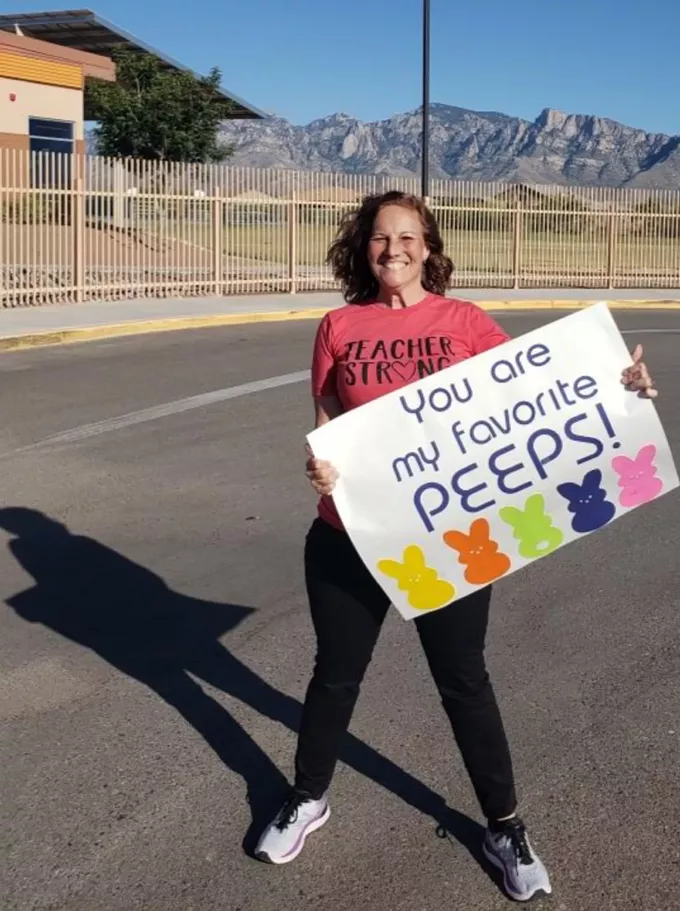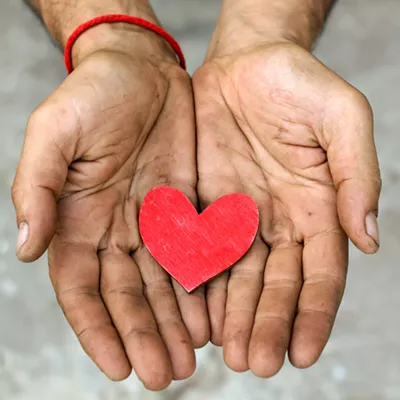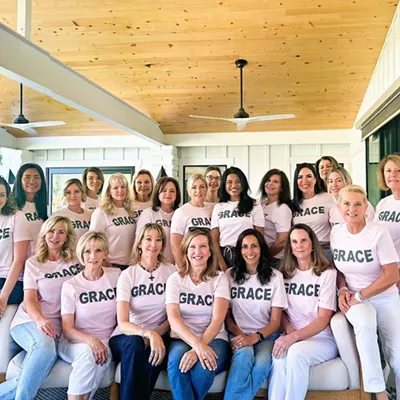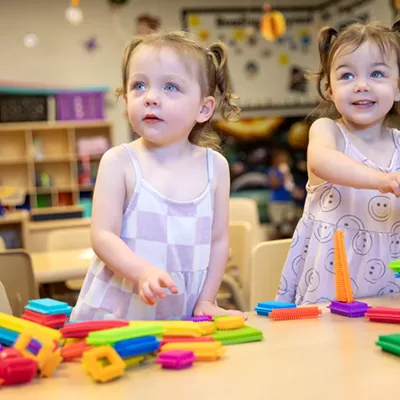Back in March of this year, I never planned on telling this kind of COVID-19 story. My story was going to be boring, as I hunkered down in my house with my husband and our young-adult children, who had temporarily returned home to quarantine with us. After 12 plus-hour days of online crisis-teaching the last quarter of school here in Arizona, I was ready for a long, casual summer relaxing and rebooting with my family.
In lieu of a family vacation, we invested in resurfacing our aging pool, because we knew we were going to be spending a lot of time at home as we watched COVID-19 ravage my home state of New York and other parts of the country. We planned on long months of family game nights, hiking, binge streaming, lots of cooking and eating, and basically relishing poolside in this time together as we took turns checking in on my elderly, but energetic parents who opted to stay in Arizona for the summer and not return to the COVID-19 epicenter of their native New York this past spring.
However, this is not my story.
My story is that a war has been raging in my body for the past five weeks. My seemingly never-ending battle with COVID-19 is my new story. It is a story that people need to know.
First, what you need to
know is that being a life-long asthmatic has shaped the way I think about my health and the miraculous functions our bodies perform for us each and every day. That's why I've made it one of my life's missions to stay healthy, value my body, and honor what it does for me. During normal, non-COVID times, you can find me teaching an invigorating spin class at the local YMCA before the school day starts. My love and need for exercise helps set the tone for the day so I can be the best teacher I can be for my students.
So, when the pandemic struck, I knew it was going to be vital that I remain sequestered from friends, my elderly parents, and my beloved students. No grocery shopping, no strolls through the aisles of Home Depot, no public outings, just a daily 5K walk through my neighborhood at the crack of dawn. This was going to be tough, but I was committed to remaining healthy so I could continue what I started the previous school year with my third-grade students who were going to stay with me for their fourth grade year. I was excited to continue to cultivate and grow with this incredible group of kids! As I write this, I don't know what my next school year is going to look like largely due to the havoc that COVID-19 has wreaked on me and my community.
My new story starts three months into a strict home quarantine on June 11. Gov. Doug Ducey had recently opened up the State of Arizona and relaxed the mandatory lockdown. Still wary and practicing safe social isolation, my husband and I met up with a small group of teacher friends to say goodbye as my husband moved on to a new job. We enjoyed an appropriately distanced gathering. Over the next few days I continued my 5K walking routine, and dropped in for a visit with my home-bound folks. It's been so hard to see my parents and not be able to hug them. So, we settled for our customary outside visit as my daughter traveled to the market for their groceries.
At the time, the Tucson skyline of our majestic mountain range surrounding our city was ablaze with one of the nation's largest, uncontrolled wildfires, the Bighorn Fire. I sat with my parents and watched the fire and smoke jump from one ridge to the next, marveling in how a marginal amount of wind pushed small, floating embers on untouched trees and grasses, igniting new hot spots around the mountain.
On smoky June 15, the fire continued to rage above our town. Feeling a bit pent up, I decided to go on my first public outing; I went to the gym for a cycling class, distanced 10 feet apart in masks, then I went to Starbucks with friends. We walked and talked. It felt so good! When I got home, my normally energetic husband was feeling a bit achy and lethargic. We thought it might be from the air pollution and exercising. In the back of my mind, it had also been four days since our friends visited.
By June 17, my husband had been sleeping for several days and was officially sick. I also began to feel really achy. I thought (more like hoped) maybe getting back to the gym was too much; I couldn't even bend down. I skipped the gym and walked my usual 5K feeling dizzy and lethargic. I was also still coughing. I felt like something was taking over my body. I took Tylenol and Ibuprofen, hoping that I was just sore from my long-overdue return to vigorous workouts.
Feeling worried, I texted some of the friends who were at my house on June 11, and asked if they were feeling sick. One of my friends confirmed my worst fear; they were sick with a confirmed positive COVID-19 test. Shortly, we learned that almost all of our visitors were COVID positive. My kids, hubby, and I all immediately piled in the car and headed for an urgent care that performed rapid tests. Because my husband was already sick, they performed a rapid test on him. The kids and I all had mild fevers of 99 degrees, so they administered a regular test with a 5-10 day turnaround time. Surprisingly, my husband's rapid test results were negative. On the way home, we stopped at eegee's, a local sub and Italian ice shop, thinking an icey, sugary eegee's drink would make me feel better. I couldn't even finish the kiddee-sized ice concoction. I officially had no appetite. Upon returning home, not knowing what to think about all of our results, we each quarantined ourselves in various areas of the house.
Ironically and frankly, sadly,
June 18 marked my 51st birthday, but I felt like death. I was sick with a fever, headache, nausea, and a whopping case of debilitating lethargy—all nagging symptoms that persist weeks later as I write this. I slept most of the day away. I tried to play some board games with my kids to "celebrate" my birthday, as I struggled hiding how sick I was from them.
June 19 is a blur. I don't remember much beyond vomiting everything I tried to eat and sleeping the day away. I do remember throwing up Gatorade without warning on my brand new carpet. As I frantically tried to clean it up, I dizzily fell over. I had to drag myself to the bathroom to sit fully clothed in the shower as the water washed away my stomach contents.
June 21 was Father's Day. I stayed in bed all day. I left my Father's Day gift on the door for my dad to pick up. My parents, now on their own, had to start doing their own shopping. My family and I attempted a Father's Day Zoom call with all five of my siblings and my parents. We had been doing this biweekly. I know they could tell that I was sick, but I tried to hide how horrible I felt. Later that night our urgent care test results came back. It was confirmed; I officially tested positive for COVID-19. The kids' tests came back as negative. My husband was still sick, so they asked that he retest. In my weakened state, I immediately contacted Starbucks, the gym, and all the friends that I saw between June 11 and June 16.
On June 22 I woke up extremely short of breath with a pounding headache. I got up to inhale a breathing treatment and projectile vomited all over myself. Again, I sat in the shower and this time I cried. I didn't even have the stamina to stand. I left the wet clothes from this day and the previous day to sit abandoned and unwrung at the bottom of the shower. The rest of the day was a tradeoff between breathing treatments and ragged sleep as the Chinook helicopters, heavy with water bladders, flew over our valley straight into the blaze that continued to creep up the mountain into the timberline.
June 23 arrived with me coughing up my own metallic-tasting blood. I measured my breathing and vomited relentlessly until I dry heaved, producing nothing but stomach acid. The blood left a metallic taste in my mouth and the distinct campfire smell that blanketed our community lingered in my nose. I felt hungover, like the worst, most toxic, alcohol poisoning hangover, and I don't even drink. For some reason, I craved garlic, but I couldn't eat. I welcomed sleep because my mind could escape my ravaged, hurting body if I was asleep, even though my sleep was terrible. I was constantly interrupted by my body crying out with the raging virus. I was getting desperately sicker.
On June 24 I remember coughing up blood again and feeling scared. A friend dropped off an oxygen monitor. My numbers were low, but not too low. I didn't vomit, but I slept a lot—not good sleep, a dull, throbbing, headache kind of sleep.
By June 25 I woke up feeling different with no fever and no headache, but then I coughed up some blood and remembered, "Oh yeah. I still have this." Then, I was struggling to breathe. My son checked on me all the time and made sure that I was eating; he did everything for me these days. That morning I absently stepped on the scale just to see. I lost 10 pounds! I was sure part of the weight loss was from my ravaged lungs and my throbbing brain. I had no ability to focus or concentrate on anything except my breathing, but miraculously, I didn't have a fever!
I forced myself to eat my usual Cream of Wheat for breakfast; I could only manage three tablespoons of the smooth and comforting porridge, but I knew it is what I needed. At least I could keep that down after days of my stomach rejecting everything. Around 11 a.m. my son came in and told me he had been observing me and that I was not "okay." He instructed me to put on my shoes, and he took me to the hospital where he had to drop me off unattended due to the new COVID-19 policies in effect. Once I was there, I rattled off my symptoms of the past nine days, thinking surely after this long, and now with no fever, I MUST be getting better.
Nope.
After hours of tests and talking to providers tripled layered in disposable PPE, which they shed and reapplied every time they left my room, they confirmed another positive COVID-19 test. After poking, prodding, an EKG, and chest x-ray, they determined I had pneumonia, a complication of COVID-19, which was the culprit of my continued dizziness and shortness of breath. However, the doc was amazed by my blood work; none of her COVID patients had iron-rich blood. I was the first that was not anemic. I joked with myself that maybe that old fashioned, iron-fortified Cream of Wheat was a panacea.
I could smell the smoke from the fire in my exam room as I fell asleep waiting for my tests, so I have no idea how long I was there. Finally, the doctor determined that between the EKG and my otherwise normal blood work, I seemed sort of healthy for a COVID, so she sent me home with some antibiotics and my promise to return if things got worse. She also warned me that my recovery would be long. After I texted my son to pick me up, they instructed me to walk outside, careful to not come near me. I waited for him on the curb, swaying and dizzy. When we got home, I crawled into bed, and slept between breathing treatments, thankful I hadn't thrown up that day. I woke to a new symptom: diarrhea! The top of my body was empty, so now the virus was going to attack the rest of me.
On June 28 I set an alarm for the family Zoom. I kept my face blacked out because I was so sick. My fever had not returned, but I was miserable with diarrhea, shortness of breath, dizziness, lethargy and lots of rough sleep.
On June 30 I tried to go back to my online tutoring students from bed. I gave it my all and then slept the rest of the day. I was simply breathless, dizzy, and lethargic, but my tummy issues subsided, finally. In the past days many people have reached out to me, asked what they could do or what they could bring me. These were all difficult questions because I didn't need anything they could possibly give me. I needed to feel better.
On July 1, I was fever-free, long enough to join the family without a mask. I walked with my son; the air felt good and was finally clear on our side of the mountain due to the blaze moving on the backside of our range headed east. I was still short of breath, dizzy, and with the ever-present headache. (Even today, I wonder what it is like to NOT have a headache.) The walk helped me sleep, though.
July 3 was our 25th anniversary. My husband started to feel better after being sick with fever, no appetite, and extreme fatigue for three weeks. So, I wanted to try to celebrate with my family. We ordered take-out from the restaurant, Caruso's, where we had our first date. I administered a breathing treatment and rode along in the car to pick up our dinner. The car ride made my head hurt and reactivated my dizziness, but being with my kids and my hubby was worth it. We ate at home, reminisced, and watched Hamilton. I went to bed exhausted.
July 4 was Independence Day in America, but I was indentured to sleep in my bed all day. I did get up to do breathing treatments because I was really struggling.
On July 7, I walked. It took a long time, but I did it. I went back to working remotely, but by the end of the day, I couldn't breathe. I was breathless, dizzy, and lethargic.
Since then, every day is
the same. It has been a month and I am still waking up sick, dizzy, breathless, and exhausted. It's my new normal. I'm scheduled to follow up with the doctor this week. Until then, I was told to expect a long recovery time. Every day is filled with so much uncertainty as both a recovering COVID-19 survivor, living with pneumonia and as a teacher. My colleagues and I are worried for our students, their families, and our families, and ourselves.
As COVID numbers continue to rise in our state and people I know, including children, become infected, I'm overcome with a dreaded sense of the unknown. What I DO know is that I am fearful for the lives of my co-workers, our staff, my boss, my students, and my community. I have felt the ravages of what this disease can do, and I dread the thought of becoming re-infected or seeing people I love and care for fall victim to a hasty decision to open schools. I am personally witnessing how this virus is roaring through our community. Its invisible embers are like a thousand lit Roman candles landing on dry, desert tinder. This COVID-19 wildfire is illusive, but deadly. It's like a wildfire without any firefighters; it goes wherever it wants and spreads quickly and viciously.
So, where does my story end? I suppose it will end when I get well, when I can walk my 5K with ease, maybe even run, and when I can safely embrace my family, friends, co-workers and students after so many months away from them. Maybe my COVID-19 story never ends. Maybe this story is supposed to be passed on, shared, and hopefully illuminate the many complicated problems that are associated with this pandemic and our eagerness to return to life as it was. There are so many unanswered questions about accurate testing, transmission, our vulnerable populations, the long-term effects of those infected, and of course how this is impacting our children and their families. As a teacher, my duty to my students will be to return to the classroom, if that is what the governor orders; however, it will come at an unknown cost. I love my job, but I love my health more. Being a COVID survivor (so far), I wrote this to help everyone understand how this devastating virus impacted me and my family's lives. Perhaps by reading this, it might help parents better prepare to protect themselves and their children returning to our classrooms this fall, if it comes to that. The bottom line is that this COVID-19 wildfire is out of control, and we don't have the means to stop it. We must stop pretending that we do.
"Education is improving the lives of others and leaving your community and world better than you found it."
—Marian Wright Edelman
Niki Bolze Tilicki is an elementary school teaching veteran at Innovation Academy in Oro Valley. She has almost 30 years experience in elementary and middle school teaching and counseling. She holds a bachelor's degree in education, a master's degree in counseling, and certificates in middle school math and science.
April A. Burge is a community college writing instructor at Pima Community College. She has almost 20 years experience in high school and post-secondary education. She holds a bachelor's degree in English and mass communications and a master's degree in English education with a post baccalaureate certificate in secondary education language arts.








